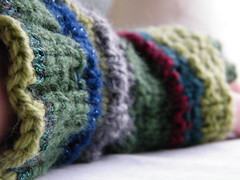Well, it has been a month since #plateaknit took place and I'm only now feeling able to wrap it up. I must admit to having had total knitting burnout, not to mention writer's block over the project. Five intensive days of knitting, knitting, knitting for hours took the fun out of it, to be honest. But eventually, as with all things, it worked itself out and here I am again.
If you missed it at the time, or if you would like to follow the entire performance and knit or make something from the tweets, you can visit the hashtag vault for #plateaknit, archived on twapperkeeper.
From 25th-29th January, @platea's Project 6, #plateaknit took place. The idea was to perform #plateaknit by crowdsourcing knitting instructions and make up designs via the Twitter hashtag #plateaknit. There were two types of participants in #plateaknit: instructors and makers. @Platea asked the instructors to use the hashtag #plateaknit when they gave the makers abbreviated knitting instructions in a tweet. These were be picked up by the makers and incorporated into the piece they were knitting, or making in some other way. Although we primarily made use knitting abbreviations, it was important that makers used whatever media they liked to interpret and perform.
That is all very well on paper, but how did it work in practice?
I performed #plateaknit as both an instructor and a maker. The project gave myself and others the freedom to instruct in uncommon ways and without necessarily knowing how others would interpret it or indeed if they would at all. Due to none of us knowing how the finished items would turn out, the conventional order of succession of the pattern, and even the usual abbreviations within the language of a knitting pattern were suspended. Several things stood out from the volley of instructions given across Twitter. As well as the conventional knitting recipes tweeted, there were instructions which pertained to transient events which even now are no longer current and that may in the future defy easy explaination or interpetation. The two main examples were Apple's launching the iPad and the UK's Iraq Inquiry. These gave rise to tweets such as:
#plateaknit INSTRUCTION wrap & turn (a short row) when anyone in your twitter stream mentions #Blair #IraqInquiry (@brendadada)
and
#plateaknit kfb every time someone tweets about the Apple tablet (@thatwaszen)
The temporal nature of the project came out again in the use by @InnBrooklyn of instructions to be interpreted first via morse code and then knitting. Knitting into your hat what you had for lunch on a given day will change whenever you knit this, but unlike our interest in Tony Blair's apparant misdoings, lunch remains a constant. There was also the option of ReTweeting an instruction at will, in order to repeat it:
RT @Bungy32: Weave an 8" bit of yarn into the next 9 stitches. Let leftover tails dangle on RS of piece. RT this instr. to repeat. #plateaknit
I felt that the instructions given by those who were not knitters were particularly interesting. Although some did make use of 'conventional' abbreviations, most gave us rather more out-there tweets including @newcurator's 'knitting interlude' the results of which you can see on his site.
Hello #plateaknit crew! For the next row only: close yr eyes & trust yr inner-knitter (@sortingtrolley)
...and how did all of this translate when making something from it.
As knitters we are used to following a pattern: this was DIFFERENT. Oh yes. In being a maker, I dipped in and out of the feed, as and when I was on twitter. I knitted for about 5-6 hours each of the five days and ended up making two hats, some wrist-warmers and starting a full-instruction scarf too. Initially I had chosen two greens as my base colours and knitted predominently with them. Changing colours when instructed, adding and subtracting stitches and yarns, and interpreting others' instructions as I pleased. I did wonder though, whether my instructions were being influenced by what I was making, rather than the other way around. For instance, I fancied a bit of zing in my hat, so I tweeted an instruction to 'make the next five rows sparkle'. I'm not sure whether that matters or not either.
There were a lot of scarves knitted from the instructions and a long, flat item does lend itself to the instructions rather well: much like a visual print-out.
@_randomthoughts made a great interpretation of the tweets in her drawing, below.
I think that Christi Nielsen summed up the project best of all when she described her #plateaknitting as 'a roadmap, of sorts, of your tweets the last few days'.
 @plateaknit by Christi_Nielsen. Used under Creative Commons licence
@plateaknit by Christi_Nielsen. Used under Creative Commons licenceYou can see more of our #plateaknits in the Flickr group pool.
I'd like to extend my thanks to all participants in #plateaknit, both instructors and makers, and say a big thanks you to An Xiao for letting me be the first resident for @Platea Project Space.
















No comments:
Post a Comment